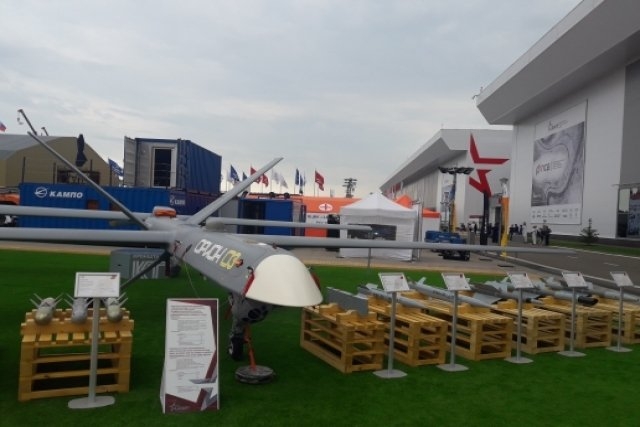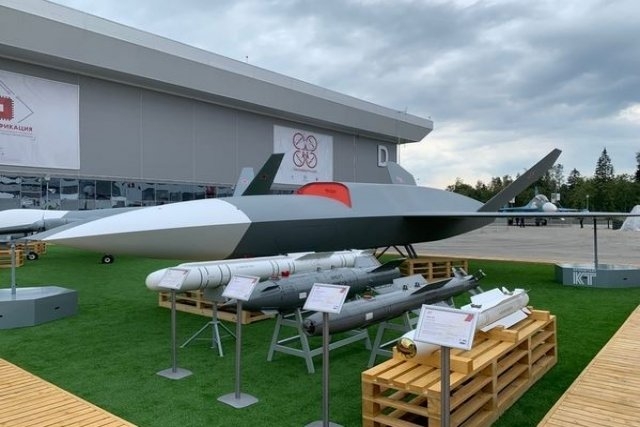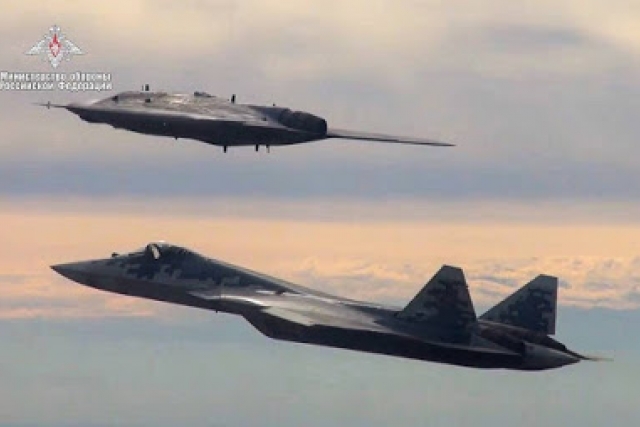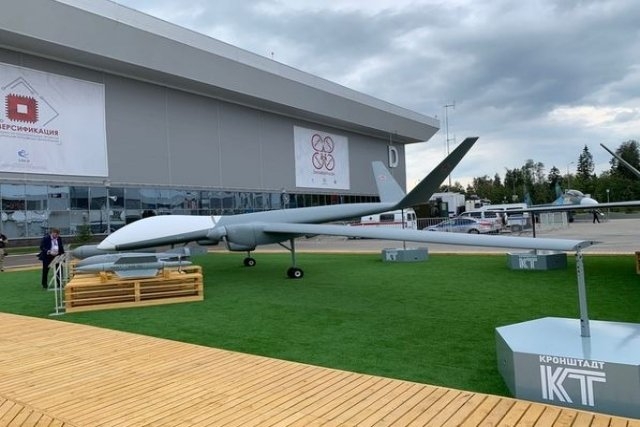Russian Drone Attack

Orion MALE attack-reconnaissance drone at Army-2020 expo
After lagging behind major drone powers such as the United States, Israel and China, Russia is attempting to challenge, if not forge ahead of some of its competitors. Russian companies displayed several drones - both for attack and reconnaissance / surveillance at the Army-2020 Forum in Moscow whose features match if not exceed that of competing drones from international manufacturers.
We present a sample of these new Russian drones to see if they can find a market beyond the Russian armed forces.
Unmanned aircraft nowadays come equipped with several state-of-the-art technologies; namely, cloud computing-based services, multi-sensor data fusion for UAV navigation, and artificial intelligence (AI). While advanced jets cost a bomb, drones are generally more economical. Effectiveness in active battle zones such as Syria and Libya, where drones have destroyed tanks and brought down fighter jet, have turned focus on them.
In Syria and Libya, Chinese and Turkish drones hogged the limelight due to their lethal attacks on largely Russian air defence systems which are primarily designed as defence against fighter jets. Their relatively low cost, lethality and expendability has made them the first choice of armies as well as militia groups.
A report published by Fortune Business Insights earlier this year projects Military Drone Market size is projected to reach $21.76 billion by 2026 at a Compound annual growth rate (CAGR) of 12.4% during the forecast period. However, it stood at $7.93 billion in 2018.
China currently holds a lion’s share in world drone exports. Stockholm International Peace Research Institute (SIPRI) stated in a report last year that China recorded an overall increase of 1430% growth between 2014 and 2018 in combat drone sales pushing it to the number one spot. Other countries that are doing well in the drone exports race are United States, Turkey and Israel.
While being at the receiving end of drone attacks, Russian designers have developed drone attack and reconnaissance systems based on real battle experiences.
Going by the variety and technology of Russian drones displayed at the Army 2020 Forum held in August, it can rightly be said that the new drones taking off from Moscow that look promising enough for military buyers to take notice.
We sample a few of the promising drones and what they can do.
Attack drones
Orion
At the Army-2020 expo, privately held company, Kronstadt presented the Orion heavy UAV with a full set of weapons. Orion can carry four guided bombs or four missiles and has maximum payload of 200 kg. One of the munitions is the 50-kg guided UPAB-50S is intended for destroying personnel and equipment at up to 30 km ranges. The warhead types could be of HE fragmentation, cluster, fuel-air explosive types. New weapon guidance system has been installed and tested on the Orion, says Kronstadt.
The Orion drone has a service ceiling of 7.5 km and its maximum flight duration with the standard payload is 24 hours. The drone can fly at speeds of up 200kmph. With its maximum take-off weight of 1,000 kg, the Orion-E can carry a 200 kg payload of four 50-kg or two 100-kg munitions.
The updated Orion compares with America’s MQ-1 Predator drone built by General Atomics.
In its reconnaissance-only version designated Orion-E, the drone is intended for day-and-night aerial ISR missions, says the official promotional paper of Kronstadt. Orion-E is capable of performing aerial intelligence, reconnaissance and surveillance; target detection and tracking; aerial mapping; strike damage assessment; radar survey; SIGINT/COMINT. The EO/IR system implements ground targets search and detection in infrared and visible spectrum.

Thunder (Grom in Russian)
The stealthy Thunder can attain speeds of about 1,000kmph. Weighing 7 tons, the drone has a payload of 2,000kg. The drone can carry 100kg, 250kg and 500kg bombs. It has four suspension points - two under the wing consoles and two inside the fuselage. Combat radius of the drone is 700km and it can reach altitude of 12,000 meters. Height and wingspan of the drone is 3.8 meters and 10 meters respectively.
The Thunder is intended to function as a ‘loyal wingman’ to the Su-57 E flying alongside the stealth jet at speeds of up to 800 kmph, provide reconnaissance data and fire missiles at a command form the manned jet.
“The Thunder is designed to support Su-35 and Su-57 fighter jets,” Nikolai Dolzhenkov, general designer of the aircraft development company, Kronshtadt, told reporters during Army-2020 on August 24.
Okhotnik (Sukhoi S-70 Hunter)
Okhotnik is a stealth-capable heavy drone that has a low signature, a flying wing design, and a take-off weight of 20 tons. It is made of composite materials and a radar-absorbing coat. The aircraft is powered by an AL-31 turbojet engine and is being outfitted with electro-optical targeting, radio, and “other types of reconnaissance equipment.”
The Sukhoi S-70 Hunter is way larger than its Western counterparts like Dassault nEUROn and Northrop Grumman X-47B. With 20 meters in wingspan and a length of 14 meters, its mass is supposedly around 20 tons (against 4.9 for the Dassault nEUROn and 6.3 for the Northrop Grumman X-47B). In fact, tipping the scales at 20 tons, Okhotnik is about as heavy as a two-engine American F-15 Eagle fighter.
It is expected to fly at a speed of 1,000 kmph, for a range of 6,000 km and its two internal bays should embark up to 2.8 tons of weapons.
It took off on its maiden flight that lasted over 20 minutes on August 3, 2019. In the following month, the Okhotnik performed a flight together with a Su-57 fifth-generation fighter jet. The drone manoeuvred in the air in the automated mode at an altitude of around 1,600 meters and its flight lasted over 30 minutes.
Artillery fire and bomb guidance drone
Orlan-30
The Russian army is expected to receive the latest Orlan-30 drone in 2020, which is a quick-deployable battlefield support system. It has been tested in Syria and at the Center-2019 strategic manoeuvres. Orlan-30 can reconnoitre targets and provide exact coordinates by GLONASS and GPS space navigation systems. The Orlan-30 uses laser illumination for fire with smart ar6-0-artillery shells and for guiding precision air bombs.
Russian UAV expert Anton Lavrov believes. "Laser illumination of the targets will provide sniper accuracy to artillery. Orlan-30 will interact with heavy artillery, e.g. Tyulpan 240mm mortars with Smelchak guided mines. 152mm artillery weapons fire Krasnopol shells. Their flight at the final stage is adjusted by laser marks on the target," he was quoted as saying by Izvestiya last October.
The new vehicle resembles its predecessor Orlan-10. However, its launch weight is close to 30 kg which is twice as big as Orlan-10 has. The drone can fly to a distance of 300 km from the control post at a cruising speed of 150 kmph. Flight duration exceeds five hours. The characteristics allow effective engagement far behind the frontline.
The modular architecture allows changing the payload and onboard equipment. The drone is launched by a catapult which needs small sites and saves fuel.
Orlan-30 can operate with Krasnopol 152mm smart projectiles fired by self-propelled Acacia and Msta-S artillery guns.

Reconnaissance and Surveillance
Sirius
Russia had unveiled its biggest ever drone yet- the 30 meters wingspan -surveillance drone named Sirus during MAKS-2019, that puts in the league of the US-made MQ-9A Global Hawk. To put the drone’s size in perspective, the Boeing 737-800 has a wingspan of 35.8 meters while the larger Global Hawk’s wingspan is 39.63 meters.
The drone has length of 13 meters with a maximum take-off weight of 5 tons and maximum payload of 1 ton. Its cruising speed will be 295 kmph and endurance of 40 hours with full payload.
Its service ceiling is 12000 meters making it a true long range high altitude drone. Its mission profile is aerial patrolling over large swathes of sea, aerial inspection of immense territory, long haul emergency and even express delivery of cargo, information released by Kronstadt said.
It will be powered by turbojet engine most likely derived from current Russian high performance engines.
The payload options for the drone could include infrared thermal and electro-optical. The drone will be connected to ground control by a secure data link and will have self-destruct capability should its controls be seized by the enemy.
Cyclocopter
The Cyclocopter drone was unveiled during Army-2020 Forum. It reportedly features better maneuverability, considerably smaller dimensions and shielded rotors, which helps the vehicle operate close to buildings and other obstacles. Tests of the unmanned aircraft, capable of vertical take-off and landing, were concluded recently. The project to develop a vertical lift and landing drone with cycloidal rotors was approved in late 2018.
Helios
This drone is equipped to handle radar surveillance and assist in guidance. The Helios is a five-tonne radar surveillance and guidance drone. When used as radar, it will most likely be fitted with part of the radar station used in the Beriev A-100 ‘Premier’ early warning and control aircraft.
Altius-U
The Altius-U medium altitude long endurance (MALE) with endurance of 24 hours is capable of performing an entire spectrum of reconnaissance missions using optical, radio engineering and radar.
The Russian drone made its debut flight in August 2019. The flight took place for 32 minutes at an altitude of up to 800m in fully automatic mode at one of the test aerodromes. The MoD posted a video of the maiden flight of a 6-tonne Altius-U drone.

Korsar
Korsar high altitude reconnaissance drone system, can operate from heights in excess of 5000 meters. It was first demonstrated for the first time at the Army 2019 forum.
The Korsar system has been developed by Lutch Design Bureau (part of Ruselectronics) has a flight range of at least 100 km, flight speed of 100 to 180 kmph, and continuous flight duration of at least 7.5 hours.
The working height of the UAV flight is 100 to 4000 meters. The take-off mass is 200 kg, it has a wingspan is 6.5 meters, and fuselage length of 4 meters. Korsar can be equipped with optical electronic systems, a radar station, a digital aerial camera, meteorological equipment, and a cargo unit.
The Korsar project encompassed creating innovative power generation systems, a small-sized engine starting system, and an electronic controller for the power unit of the unmanned aerial vehicle. Its advantage is the network-centric principle of information network organization, used by the developers to facilitate the connection of the UAV to the control center and other parties. The communication system implemented on the drone links to other air and ground objects to form a secure network, which transmits information to the recipient with no delay or loss.
ZALA 421-16EV
ZALA Aero, an Izhevsk-based UAV developer and subsidiary of Kalashnikov Concern, presented its own unique drone complex at ARMY-2020. The drone, known as the ZALA 421-16EV, features a tiltrotor design enabling for vertical take-off and landing.
The platform is said to be ideal for missions including surveillance and aerial photography in difficult-to-reach areas, as it doesn’t require a runway. The drone is said to have a cruising speed of up to 110 kmph, an airborne time of 2 hours, an onboard computer for the recording and streaming of multiple channels of Full HD video, and automatic target tracking, along with an encrypted hard drive.
Leading Russian Drones’ Specifications
|
Specifications |
Orion |
Thunder |
Okhotnik |
Sirius |
Orlan-30 |
|
Measurements- Height, Wingspan, Length |
- |
3.8m, 10m, 13.8m |
Xm, 20m, 14m |
Xm, 30m, 13m |
|
|
Service Ceiling |
7.5 km |
- |
- |
12 km |
5 km |
|
Payload |
200 kg |
2,000 kg |
2800 kg |
1,000 kg |
7kg |
|
Max Speed |
200 kmph |
1,000 kmph |
1,000 kmph |
295 kmph |
170 kmph |
|
Max Take-off Weight |
1 ton |
Weight: 7 tons
|
20 tons |
5 tons |
30kg |
|
Altitude |
7.5 km |
12,000 m |
600 m in maiden flight |
- |
|
|
Endurance |
24 hours |
- |
- |
40 hours |
5 hours |
|
Unique features |
Can Collaborate with SU-35, Su-57 Jets |
“Loyal Wingman” to Su-57 Stealth Jet |
Laser aimer to illuminate targets |









